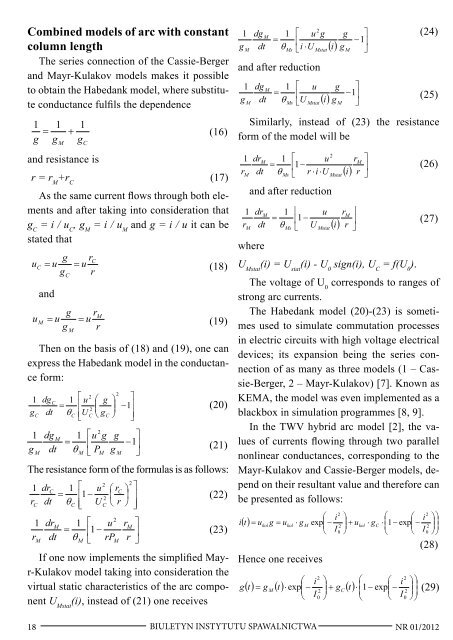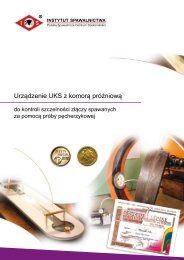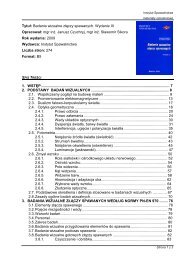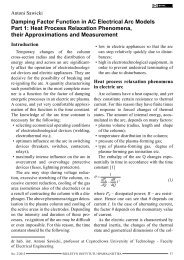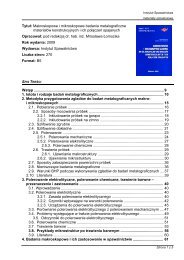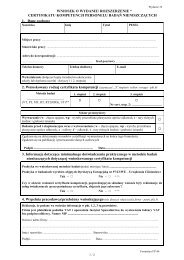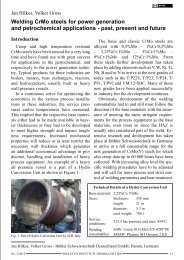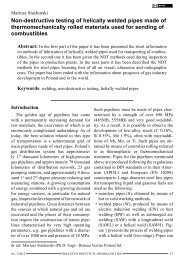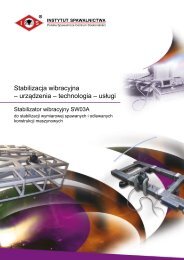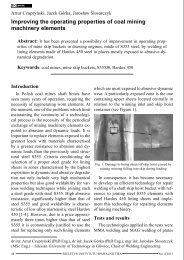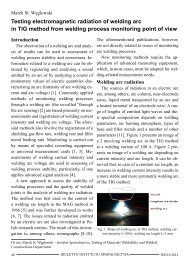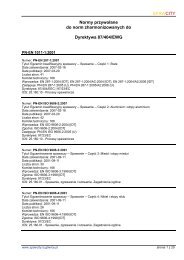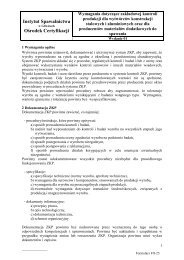Biuletyn Instytutu Spawalnictwa No. 01/2012
Biuletyn Instytutu Spawalnictwa No. 01/2012
Biuletyn Instytutu Spawalnictwa No. 01/2012
You also want an ePaper? Increase the reach of your titles
YUMPU automatically turns print PDFs into web optimized ePapers that Google loves.
Combined models of arc with constant<br />
column length<br />
The series connection of the Cassie-Berger<br />
and Mayr-Kulakov models makes it possible<br />
to obtain the Habedank model, where substitute<br />
conductance fulfils the dependence<br />
(22)<br />
(23)<br />
If one now implements the simplified Mayr-Kulakov<br />
model taking into consideration the<br />
virtual static characteristics of the arc component<br />
U Mstat<br />
(i), instead of (21) one receives<br />
and after reduction<br />
1 1 1<br />
Similarly, instead of (23) the resistance<br />
= +<br />
(16)<br />
(16)<br />
g g form of the model will be<br />
M<br />
g C<br />
1<br />
r<br />
C<br />
1<br />
r<br />
M<br />
drC<br />
dt<br />
dr<br />
dt<br />
M<br />
1<br />
=<br />
θ<br />
C<br />
⎡ u<br />
⎢1<br />
−<br />
⎢⎣<br />
U<br />
2<br />
2<br />
C<br />
⎛<br />
⎜<br />
⎝<br />
rC<br />
r<br />
2<br />
⎞<br />
⎟<br />
⎠<br />
2<br />
1 ⎡ u r<br />
= ⎢ −<br />
M<br />
1<br />
θ ⎣ rP r<br />
M<br />
M<br />
⎤<br />
⎥<br />
⎥⎦<br />
⎤<br />
⎥<br />
⎦<br />
1<br />
g<br />
M<br />
1<br />
g<br />
M<br />
dg<br />
dt<br />
M<br />
dg<br />
dt<br />
M<br />
2<br />
1 ⎡ u g g ⎤<br />
= ⎢<br />
−1⎥ θ<br />
Ms ⎣i<br />
⋅U<br />
Mstat<br />
() i g<br />
M ⎦<br />
1 ⎡ u g ⎤<br />
= ⎢ −1⎥ θ ⎣ U () i g ⎦<br />
Ms<br />
Mstat<br />
M<br />
(24)<br />
(25)<br />
2<br />
and resistance is<br />
1 dr ⎡<br />
⎤<br />
M<br />
1 u rM<br />
= ⎢1<br />
−<br />
⎥ (26)<br />
rM<br />
dt θ<br />
Ms<br />
r = r M<br />
+r C<br />
(17)<br />
⎣ r ⋅i<br />
⋅U<br />
Mstat<br />
() i r ⎦<br />
As the same current flows through both elements<br />
and after taking into consideration that 1 dr ⎡ ⎤<br />
and after reduction<br />
M<br />
1 u r<br />
= ⎢ −<br />
M<br />
1<br />
⎥ (27)<br />
g C<br />
= i / u C<br />
, g M<br />
= i / u M<br />
and g = i / u it can be r<br />
⎣ () r<br />
M<br />
dt θ<br />
Ms<br />
U<br />
Mstat<br />
i ⎦<br />
stated that<br />
where<br />
g rC<br />
uC = u = u<br />
(18) U Mstat<br />
(i) (18) = U stat<br />
(i) - U 0<br />
sign(i), U C<br />
= f(U 0<br />
).<br />
gC<br />
r<br />
The voltage of U 0<br />
corresponds to ranges of<br />
and<br />
strong arc currents.<br />
g r<br />
The Habedank model (20)-(23) is sometimes<br />
used to simulate commutation processes<br />
M<br />
uM = u = u<br />
(19) (19)<br />
g<br />
M<br />
r<br />
in electric circuits with high voltage electrical<br />
Then on the basis of (18) and (19), one can<br />
devices; its expansion being the series connection<br />
of as many as three models (1 – Cas-<br />
express the Habedank model in the conductance<br />
form:<br />
sie-Berger, 2 – Mayr-Kulakov) [7]. Known as<br />
2<br />
⎡ 2<br />
1 dg 1 ⎛ ⎞ ⎤<br />
KEMA, the model was even implemented as a<br />
C u g<br />
= ⎢<br />
⎜<br />
⎟ −1⎥<br />
(20) (20)<br />
2<br />
gC<br />
dt θC<br />
⎣⎢<br />
U<br />
C ⎝ gC<br />
⎠ ⎥⎦<br />
blackbox in simulation programmes [8, 9].<br />
In the TWV hybrid arc model [2], the values<br />
of (21) currents flowing through two parallel<br />
2<br />
1 dg 1 ⎡ ⎤<br />
M<br />
u g g<br />
= ⎢ −1⎥<br />
(21)<br />
g<br />
M<br />
dt θ<br />
M ⎣ PM<br />
g<br />
M ⎦<br />
nonlinear conductances, corresponding to the<br />
The resistance form of the formulas is as follows: Mayr-Kulakov and Cassie-Berger models, depend<br />
on their resultant value and therefore can<br />
(22)<br />
be presented as follows:<br />
2<br />
⎛<br />
2<br />
⎛ i ⎞<br />
⎛<br />
()<br />
(23)<br />
⎟ ⎞<br />
⎜<br />
i ⎞<br />
i t = u<br />
⎜<br />
⎟ + ⋅ ⋅<br />
−<br />
⎜ −<br />
⎟<br />
kol<br />
g = ukol<br />
⋅ gM<br />
exp − u 1 exp<br />
2 kol<br />
gC<br />
2<br />
⎝ I0<br />
⎠ ⎝ ⎝ I0<br />
⎠⎠<br />
(28)<br />
Hence one receives<br />
g<br />
⎛ i −<br />
2<br />
⎞<br />
⎞⎞<br />
() t = g () () ⎜<br />
⎜<br />
⎟ + ⋅<br />
−<br />
⎜<br />
⎟<br />
⎟ M<br />
t ⋅ exp g<br />
2 C<br />
t 1 exp<br />
2<br />
⎝ I0<br />
⎠ ⎝ ⎝ I0<br />
⎠⎠<br />
⎛<br />
⎛ i −<br />
2<br />
(29)<br />
18 BIULETYN INSTYTUTU SPAWALNICTWA<br />
NR <strong>01</strong>/2<strong>01</strong>2


